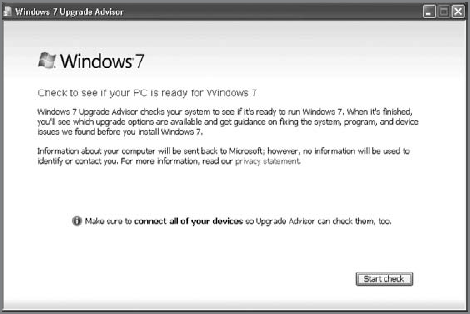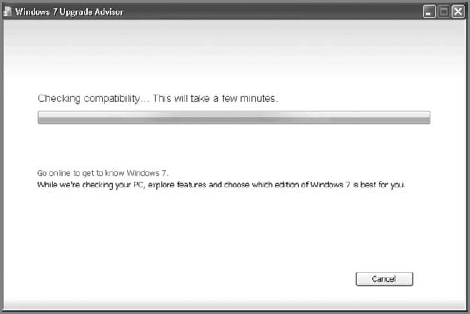1. Hidden Perils of the Windows 7 Upgrade
With all the new features and functionality provided
by Windows 7, you might be tempted to buy a retail version of the
operating system and install it over your existing copy of Windows
Vista or, in the case of Windows XP, perform a migration-type upgrade.
Your old PC may not be up to the challenge
of running Windows 7. You may need substantial investments in
additional RAM, a more capable video card, a larger hard drive, or all
of the above to get adequate performance from Windows 7.
Some
of your hardware, such as printers and networking adapters, may not
work at all after you install Windows 7—unless you update the drivers
they need to versions that are Windows 7–compatible.
Even
if you find that one or more of your drivers need to be updated, the
vendor of your hardware may not make a Windows 7–compatible version
available for months, years, or ever. (It's happened before with
previous versions of Windows.)
Some of
the software that's installed and running just fine in Windows XP may
not work properly once you've performed the upgrade.
Finally,
some software or hardware may never work in Windows 7. Companies do go
out of business, after all. Others simply stop supporting older models
to entice you to upgrade to a new machine.
We recommend that you get Windows 7 preinstalled
with your next new PC. This is the best way to acquire Windows 7.
Another reasonable option, assuming you know what you're doing and have
recent hardware, is to purchase a retail version of Windows 7 and then
perform a clean install of the OS on your existing PC. We don't recommend that you install Windows 7 over Windows Vista.
Here's why. Installing Windows 7 on top of Windows
Vista may cause incompatibility problems that you might not be able to
fix easily. When you buy a new PC with Windows 7 preinstalled, it's
almost certain that the components in the PC will have been selected
for their compatibility and will have the latest driver software. PC
makers also support their products with Web sites that provide the
latest known drivers. These sites aren't usually as up-to-date as they
should be, but they will at least work.
In general, you shouldn't consider installing
Windows 7 on a PC that previously ran Windows XP or Vista unless the
following conditions are true:
You need a feature of Windows 7 that you can't add to XP. (Much less likely with Vista.)
You need an application that requires Windows 7.
You can't afford even the least expensive new PC that comes with Windows 7 preinstalled.
Even if one of the preceding conditions is true, you
may be better off backing up all of your old data to a CD/DVD or
removable hard disk, formatting the old PC's hard drive, and doing a
clean install of Windows 7. This avoids the possibility that some
components of the old OS will hang around to cause conflicts. If you've
never backed up and formatted a hard drive, however, don't try to learn
how on any PC that's important to you.
2. The Windows 7 Upgrade Advisor
To help you determine whether your current PC has
the performance characteristics and hardware and software compatibility
needed to avoid issues before upgrading or migrating to Windows 7,
Microsoft provides a handy tool called the Windows 7 Upgrade Advisor.
The Upgrade Advisor performs an analysis of your PC
and is partly designed as a marketing tool, as it will recommend which
version of Windows 7 is right for your system. (Curiously, it almost
always recommends one of the more expensive, premium versions.) The
Upgrade Advisor also provides real-world benefit outside of Microsoft's
needs: it will tell you which hardware devices and software
applications need updates before they can work with Windows 7; and
because the back end of the Upgrade Advisor application runs on
Microsoft's servers, it always provides up-to-date information.
NOTE
While the Windows 7 Upgrade Advisor is primarily
designed to help users of previous Windows versions discover whether
their PC can be upgraded successfully to Windows 7, it also has a
secret second use: it can be run on Windows 7 and used to determine
whether your PC is able to run a more capable (and more expensive)
version of Windows 7.
1. Using the Upgrade Advisor
The Windows 7 Upgrade Advisor is a simple wizard-like application, as shown in Figure 1.

The Upgrade Advisor is designed to test two different kinds of hardware compatibility:
The Upgrade Advisor's initial screen suggests that
you should plug in any devices you may want to use with Windows 7. It's
easy to forget some, but this is absolutely the right time to have them
checked out, so here's a short list to jog your memory about the
various devices you want to ensure are plugged into your PC and powered
on before you start the Upgrade Advisor's system scan:
Printers and scanners (make sure they're powered on not just plugged in)
External hard disk drives, backup devices, and USB drives of all kinds
An extra USB hub that you seldom use—plug it in anyway to check it
Spare USB keyboards and mice that you may have forgotten
An iPod, Zune, or other MP3 player, even if you seldom synchronize it to your PC
Headphones
and other audio devices (they may require audio drivers that won't be
tested unless the devices are jacked in to an audio port).
When you've checked for all of the preceding and you
are satisfied that you've plugged in and turned on everything you might
want to test, click the Start check button in the Upgrade Advisor to
continue. Depending on the speed of your system, the scan (see Figure 2) can take anywhere from a minute or two to several minutes.
